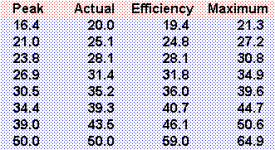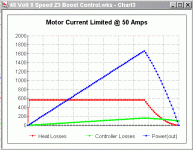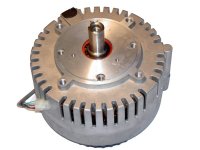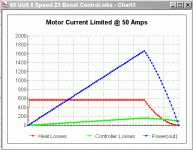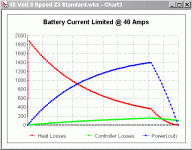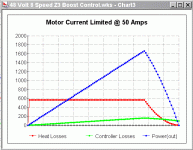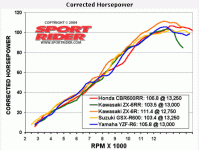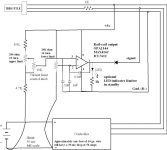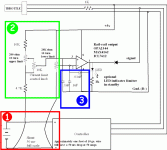safe
1 GW
- Joined
- Dec 22, 2006
- Messages
- 5,681
Torque is produced by running more current through a motor. Heat is generated by the amount of current that is used, so more torque means more heat. Power is a combined value that is the product of torque and rpm. For every motor there is a peak power where the combination of torque and rpm produces the highest power output. Efficiency is best at higher rpms and peaks at about 75% of the rpms. It's possible to "align" the power peak and the efficiency peak, but most motors place the power peak below the efficiency peak.
Okay... those are the "basics"...
 Here's the idea:
Here's the idea:
By using "Motor Current Limiting" you "suppress" the current multiplication that normally takes place when you use "Battery Current Limiting" like in a normal controller. With less current at low rpms you get less heat. (and less torque)
Now here's the "good part":
Since you've now "suppressed" the low end torque and are now generating less heat you can now RAISE the current limit so that the peak power is greater. The result is that at peak power you have MORE power and overall you are producing about the same level of heat.
With a hub motor this doesn't work. Hub motors lack the ability to shift gears to go from "peak to peak" in the powerband and have to rely on torque/heat to climb hills. This idea would provide a sort of intellectual "breakthrough" for the geared bike. Using a "peaky powerband" and gears means that you can get more power out of a small motor.
My spreadsheet shows that it's possible to take an ordinary 750 Watt MY1020Z3 and if you use a Sturmey Archer 8-Speed you can reach speeds of 50 mph WITHOUT overheating the motor!!!
For $200 you have a machine that could go 50 mph. (assuming "Road Racer" aerodynamics)
$70

$122

Okay... those are the "basics"...
By using "Motor Current Limiting" you "suppress" the current multiplication that normally takes place when you use "Battery Current Limiting" like in a normal controller. With less current at low rpms you get less heat. (and less torque)
Now here's the "good part":
Since you've now "suppressed" the low end torque and are now generating less heat you can now RAISE the current limit so that the peak power is greater. The result is that at peak power you have MORE power and overall you are producing about the same level of heat.
With a hub motor this doesn't work. Hub motors lack the ability to shift gears to go from "peak to peak" in the powerband and have to rely on torque/heat to climb hills. This idea would provide a sort of intellectual "breakthrough" for the geared bike. Using a "peaky powerband" and gears means that you can get more power out of a small motor.
My spreadsheet shows that it's possible to take an ordinary 750 Watt MY1020Z3 and if you use a Sturmey Archer 8-Speed you can reach speeds of 50 mph WITHOUT overheating the motor!!!
For $200 you have a machine that could go 50 mph. (assuming "Road Racer" aerodynamics)
$70

$122



